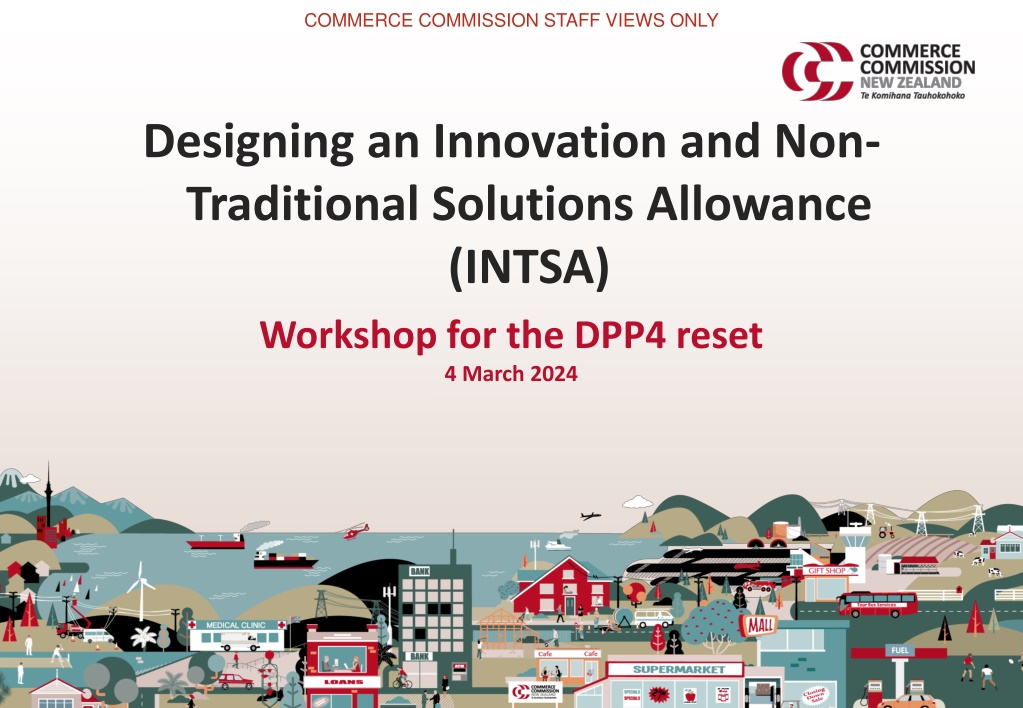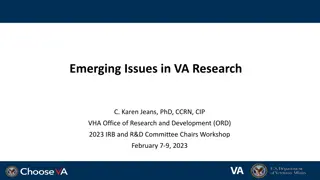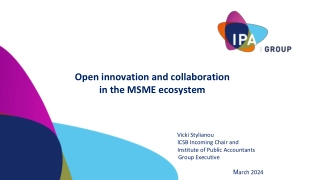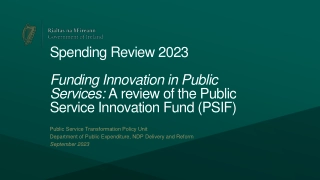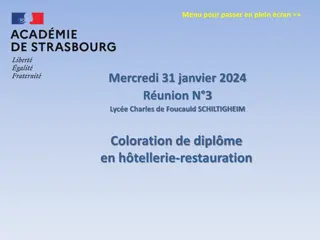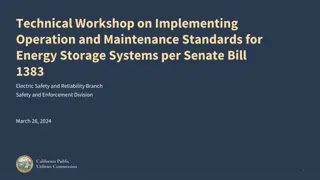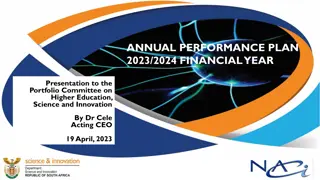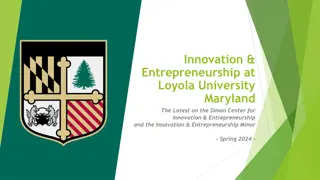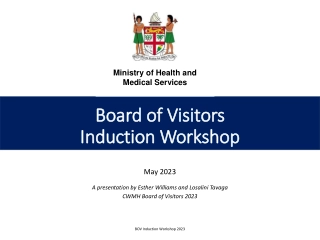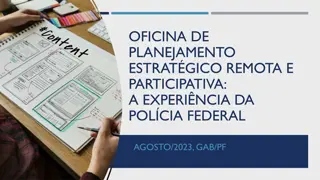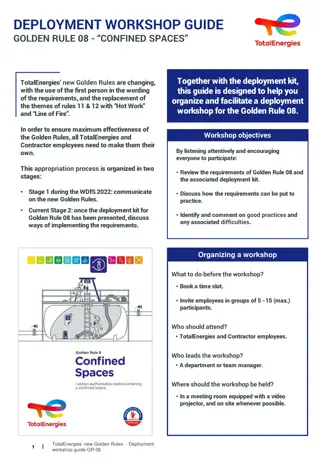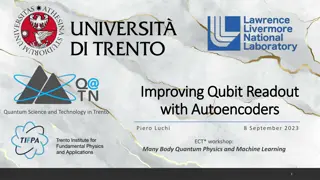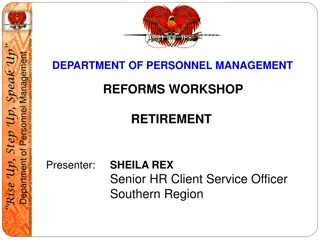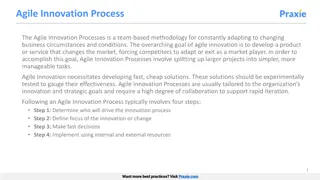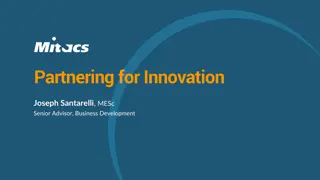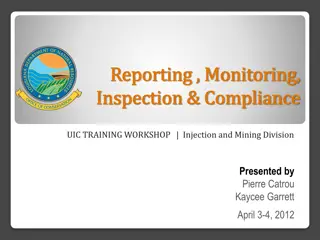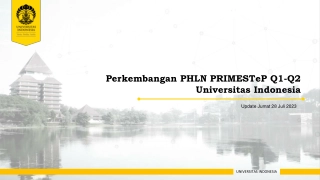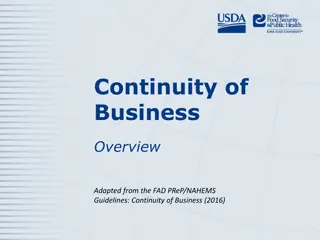Designing an INTSA Workshop for Innovation and Non-Traditional Solutions
Commerce Commission staff are organizing a workshop focused on designing an Innovation and Non-Traditional Solutions Allowance (INTSA) for the DPP4 reset in March 2024. The workshop aims to explore potential options for the allowance, receive feedback, and develop an INTSA beneficial to consumers. Discussions will cover the purpose, characteristics, and risk trade-offs of INTSA, with a focus on incentivizing long-term consumer benefits and encouraging innovation in the energy sector.
Download Presentation
Please find below an Image/Link to download the presentation.
The content on the website is provided AS IS for your information and personal use only. It may not be sold, licensed, or shared on other websites without obtaining consent from the author. Download presentation by click this link. If you encounter any issues during the download, it is possible that the publisher has removed the file from their server.
Presentation Transcript
COMMERCE COMMISSION STAFF VIEWS ONLY Designing an Innovation and Non- Traditional Solutions Allowance (INTSA) Workshop for the DPP4 reset 4 March 2024
COMMERCE COMMISSION STAFF VIEWS ONLY Overview Workshop purpose Innovation opportunities from DPP4 Role of the allowance over time What we outlined in the DPP4 Issues paper, and what we heard. Setting the characteristics of an INTSA Illustrative options Discussion topics Next steps Background slides
COMMERCE COMMISSION STAFF VIEWS ONLY Workshop purpose We are considering options for the design of the Innovation and Non- Traditional Solutions Allowance (INTSA). Today we wish to: Share our early thinking about illustrative options for an INTSA and the trade-offs between the characteristics and risk. To hear feedback and ideas for how we can develop an INTSA that is most beneficial to consumers. Draft reasons May 2024 1 April 2025 DPP3 Innovation project allowance Reset design DPP4 INTSA Final reasons November 2024 Workshop 4 March 2024 We are here
COMMERCE COMMISSION STAFF VIEWS ONLY Innovation opportunities in DPP4 EDBs have incentives to innovate under the DPP/CPP s settings through cost savings and quality standards; however There are no explicit financial incentives for benefits not realised until a later regulatory period; and EDBs may choose not to fund high risk projects, favouring traditional capex solutions. CAPEX INTSA OPEX As a result, we consider an INTSA could perform two functions. It could appropriately incentivise projects that are likely to provide long term benefit to consumers: 1. that are riskier than BAU and wouldn t otherwise happen (including non- traditional solutions); and/or 2. where benefits do not accrue until future, or through multiple, regulatory periods.
COMMERCE COMMISSION STAFF VIEWS ONLY Role of innovation allowances over time DPP3 DPP4 DPP5 IPA introduced allowing for some projects to be partially funded (one succesful application to date). The market for flexibility services in Aotearoa New Zealand has been emerging. We are working to introduce an INTSA, which was prescribed in the IMs (see background). We expect an INTSA could be used by EDBs to conduct projects and trials for innovative and non-traditional solutions. An INTSA could support EDBs to undertake projects that otherwise may be considered too risky. EDBs could harness the emerging market offerings for flexibility services and other relevant services. There may be growth in this market. EDBs innovation/non-traditional solutions capability and experience can inform what the EDB plans to achieve in DPP5. INTSA settings can be reviewed at the reset. Some EDBs may submit Asset Management Plans that include the scaling up of innovations and non- traditional solutions they have trialled in the DPP4 regulatory period using INTSA. The scaling up of those projects could be funded by the DPP5 capex and opex allowances. The market for flexibility services and other non-traditional solutions could be more robust, if it has grown to meet demand.
COMMERCE COMMISSION STAFF VIEWS ONLY DPP4 Issues paper: Principles for an INTSA scheme We proposed five principles: Submitters generally supported these principles, and suggested some additional principles: 1. Non-regulated additionality: whether a non-regulated party could offer the innovation (Contact). 2. Novel: funding would facilitate combination of new and/or existing ideas, data, technology or partners (Orion). 3. Efficient: funding would facilitate prudent investment in systems and processes that improve asset management efficiency, customer service or information transparency (Orion). 4. Limiting risk of inefficient expenditure: limiting consumers exposure to inefficient expenditure or innovation that is excessively risky (Horizon). Additionality: That the project being applied for would not otherwise occur without additional incentive . Risk allocation: Risks should be allocated to EDBs, or consumers, based on who is best placed to manage them. Proportionate scrutiny: Scrutiny applied to a scheme should be relative to the size and cost of the project. Incentives for efficient expenditure: Any funding within a potential scheme should ideally face incentives to be used efficiently . The additionality principle is the central principle for assessing whether innovation is needed. We disagree with relying on other funds to fund innovation. The availability of these funds is outside the control of the regulatory framework and they can t be relied on. This is especially true at the moment with the change in government and the review of government spending. WE* Relatively low cost: Any scheme should fit within the relatively low cost DPP settings. High complexity and cost is more suitable for a CPP.
COMMERCE COMMISSION STAFF VIEWS ONLY DPP4 Issues paper: Characteristics for an INTSA scheme In your feedback on the Issues paper we heard: Several suggestions for project type such as DSO capability (WE*); Business plan incentives (Vector); and energy hardship (Unison). Suggestions for conditions such as sharing learnings (WE*, SolarZero) or linking to EA work programme (Orion). Other suggestions such as providing process or guide (Electra, WE*);or collaboration (Orion, Flexforum). 2, Approval timing: whether the allowance is approved before or after a project starts (ex-post or ex-ante). 3. Expenditure approved: the expenditure approved for a project could be its forecast cost or its actual cost. 1. What the project is for: ie, what type and/or characteristics of expenditure. 5. When and on what conditions (if any) approved expenditure is received: timing for when approved expenditure is received and conditions for receipt. 6. Maximum expenditure permissible ($ and/or %): this is the maximum $ amount that an EDB could recover for their project costs. 4. Share of expenditure approved (%): percentage of potential project costs that would be recoverable. We suggest a different approach. We suggest that an industry learning stream of work is established that connects with the innovation allowances and funding. As industry rapidly learns through this process the AMP and DPP processes can pick up this learning. But the key point is that the learnings are applied by the industry as the learnings become available. - SolarZero 8. Penalty/reward mechanism: such a mechanism could be used to increase or reduce incentive strength to match the potential rewards to the risks faced. 7. Supporting evidence: what (ifany) supporting evidence that would be potentially required.
COMMERCE COMMISSION STAFF VIEWS ONLY Setting the characteristics of an INTSA The characteristics of an INTSA scheme can be set in different ways, for example: Approval timing could be ex ante or ex post Approved recoverable expenditure could be based on ex ante forecast or ex post actual costs The amount of recoverable expenditure could be set as a high or low share (%) of the project costs. Available funding could be capped against a share of an EDBs maximum allowable revenue. The combination of settings in an INTSA could affect the risk burden held by consumers, and/or the EDBs - as well as the likelihood that EDBs wish to undertake projects through an INTSA in DPP4. We are considering a range of combinations for an INTSA to look at how these could manage the risk burden, to an acceptable level, and deliver long-term net benefit for consumers. We see DPP4 as a potential turning point for the sector, if it were to provide the necessary incentives (and necessary risk management mechanisms) for all EDBs to commit to innovation as a core part of their asset management and investment planning. This commitment will lead to significant improvements in EDB capabilities by 2030. Rewiring Aotearoa
COMMERCE COMMISSION STAFF VIEWS ONLY Illustrative range of options Option A B C Project type Might be research based e.g. problem defining projects, feasibility studies etc. Might be tests e.g. controlled experiments, prototype development, field tests etc. Might be projects that build and operate e.g. demonstrations in a live network environment etc. Permissible expenditure Small (e.g. 0.1% of maximum allowable revenue over DPP4) Medium (e.g. 0.5% of maximum allowable revenue over DPP4) Large (e.g. akin to a reopener) % share of recoverable costs for EDBs High (e.g. 90%) Medium (e.g. 75%) High (e.g. 90%) Supporting evidence (ex- ante) Project eligibility assessment (PEA) signed off by EDB director. PEA signed off by EDB director and approved by independent expert. PEA signed off by EDB director and approved by independent expert Receipt of expenditure + conditions Reported in Annual Compliance Statement Ex-post costs approved subject to audit demonstrating costs spent correctly At a max of 110% of forecast. Full costs approved subject to net benefit to consumers achieved. Risk burden for consumers Limited because of scale Greater risk mitigated by supporting evidence and conditions Small risk mitigated by receipt of expenditure on delivery of benefits Working assumptions: This table is designed to illustrate the potential scope within which we could design an INSTA scheme in order to get feedback. These are not specific INTSA scheme design proposals. We could build an INTSA scheme that could cater for a range of projects which could potentially be at different stages/have different requirements e.g. a research and development project versus a demonstration project. Options would not be mutually exclusive. It is assumed all schemes will require learning to be disseminated in some form.
COMMERCE COMMISSION STAFF VIEWS ONLY Session 1: Discussion topics In session 1 we would like to hear from you about the illustrative examples for an INTSA scheme design. Proposed discussion topics: Types of projects that EDBs might want to undertake using INTSA during DPP4 Consumer safeguards to manage the risk burden Designing INTSA scheme accessibility
COMMERCE COMMISSION STAFF VIEWS ONLY Session 2: Discussion topics In session 2 we would like to hear from you about the balance for the trade-offs between characteristics that must be considered in setting an INTSA scheme. Proposed discussion topics: Conditions Project type/definition Share of recoverable expenditure (%) Supporting evidence
COMMERCE COMMISSION STAFF VIEWS ONLY Next steps Timeframe Activity By end of March 2024 Workshop recording and notes published on our website By Tuesday, 19 March Any submissions in response to this workshop due By end of May 2024 DPP4 Draft decision reasons paper published June 2024 Submissions on reasons paper due July 2024 Cross-submissions on reasons paper due Ongoing Any other targeted engagements that will support policy development, eg with EDBs or international counterparts By end of November 2024 DPP4 Final determination (will outline the INTSA settings) DPP4 Final decision reasons paper published (will explain how we designed the scheme and why)
COMMERCE COMMISSION STAFF VIEWS ONLY Background slides DPP3 Innovation Project Allowance Direction from Input Methodologies
COMMERCE COMMISSION STAFF VIEWS ONLY DPP3 Innovation Project Allowance To increase incentives for EDBs to be more innovative; and We received two IPA applications: Orion (declined) and Vector (approved) Definitions can be a barrier: the regime should incentivise many kinds of solutions and not be limited to "innovation" What happened What we learnt What we hoped for To encourage more expenditure on innovative projects that would promote long-term benefits for consumers We heard EDBs did not apply for more IPA funding due to narrow eligibility criteria, ex- ante engineering report, uncertainty of success and concerns about processing times The amount of money matters: the IPA was a relatively small funding source Innovation occurs outside the IPA: EDBs are willing to trial new innovative projects using their opex and capex allowances Changing the requirement for an ex-ante engineering report has led to more interest - we may receive further IPA applications under the DPP3
COMMERCE COMMISSION STAFF VIEWS ONLY Direction from Input methodologies The IM Review 2023 decision SP05 included the decisions to: rename and broaden the IPA into an innovation and non-traditional solutions allowance (INTSA); and remove the innovation project definition from the IMs. The IMs allow us to implement the INTSA as a recoverable cost subject to the conditions in the DPP (or CPP) determination. The intention for the allowance is to incentivise potentially risky projects that may not otherwise be conducted. This supports the regimes wider incentives on EDBs to embed a culture of innovating and testing non-traditional solutions in order to create long-term benefits for consumers. What we are doing now: Considering a range of scheme options within the scope of the IMs that is appropriate for the relatively low cost DPP regime. Considering the settings for the INTSA: principles and characteristics Considering that each DPP reset is a new opportunity to potentially improve an INTSA s settings to meet emerging needs and incorporate lessons learned.
